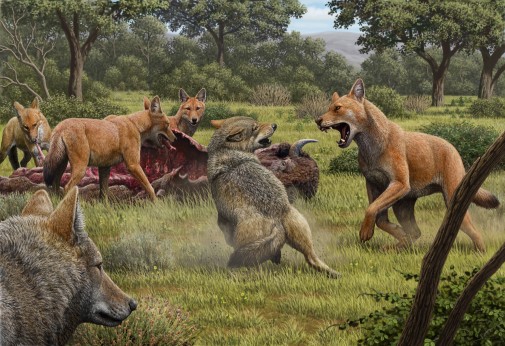Ancient DNA reveals secrets of Game of Thrones wolves
Posted on 13 January 2021
 A pack of dire wolves feeding on their bison kill, while a pair of grey wolves approach in the hopes of scavenging. Credit: Mauricio Antón/Nature
A pack of dire wolves feeding on their bison kill, while a pair of grey wolves approach in the hopes of scavenging. Credit: Mauricio Antón/Nature
Dire wolves - made famous in the TV show Game of Thrones - were common across North America until around 13,000 years ago, after which they went extinct.
The study – involving analysis from the University of York - shows that dire wolves were so different from other canine species, like coyotes and grey wolves, that they were not able to breed with each other. Previous research had led scientists to believe that dire wolves were closely related to grey wolves.
Grey wolves
An international team of scientists sequenced the ancient DNA of five dire wolf sub-fossils dating back to over 50,000 years ago. Their results showed that dire wolves and grey wolves were in fact very distant cousins.
This is the first time ancient DNA has been taken from dire wolves revealing a complex history of these ice age predators.
Researchers analysed the genomes of dire wolves alongside those of many different wolf-like canid species. Their analyses suggest that unlike many canid species who apparently migrated repeatedly between North America and Eurasia over time, dire wolves evolved solely in North America for millions of years.
Although dire wolves overlapped with coyotes and grey wolves in North America for at least 10,000 years before their extinction, they found no evidence that they interbred with these species. The research suggests that their deep evolutionary differences meant that they were likely ill equipped to adapt to changing conditions at the end of the ice age.
Dr Sam Presslee from the Department of Archaeology - helped to identify the lineage of the dire wolf specimen found at the Rancho La Brea Tar Pits, in Los Angeles, as part of her Phd.
She said: "Due to degradation, ancient DNA was not able to be recovered from this specimen, but using proteomics - which is a study of the proteins - I gained good coverage of the protein collagen which is the main protein in bone.
“When this sequence was compared to other canis collagen sequences, the results were in agreement with the ancient DNA results, that Dire Wolves were not closely related to other North American canids. "
Bones
Lead author, Dr Angela Perri from Durham University’s Archaeology Department, said: "Dire wolves have always been an iconic representation of the last ice age in the Americas and now a pop culture icon thanks to Game of Thrones, but what we know about their evolutionary history has been limited to what we can see from the size and shape of their bones and teeth.
“With this first ancient DNA analysis of dire wolves we have revealed that the history of dire wolves we thought we knew - particularly a close relationship to grey wolves - is actually much more complicated than we previously thought.
“Instead of being closely related to other North American canids, like grey wolves and coyotes, we found that dire wolves represent a branch that split off from others millions of years ago, representing the last of a now extinct lineage."
Unique
Co-lead author, Dr Alice Mouton, from the University of California Los Angeles, added: “We show that the dire wolf never interbred with the grey wolf. In contrast, grey wolves, African wolves, dogs, coyotes and jackals can and do interbreed. Dire wolves likely diverged from grey wolves more than five million years ago, which was a great surprise that this divergence occurred so early. This finding highlights how special and unique the dire wolf was.”
The dire wolf is one of the most famous prehistoric carnivores from Pleistocene America which became extinct around 13,000 years ago. Known scientifically as Canis dirus, meaning ’fearsome dog’, they preyed on large mammals like bison.
The team suggests the dire wolves’ stark evolutionary divergence from grey wolves places them in an entirely different genus - Aenocyon dirus (‘terrible wolf’)- as first proposed by palaeontologist John Campbell Merriam over 100 years ago.
The research was led by Durham University in collaboration with scientists at the University of Oxford, Ludwig Maximilian University in Germany, the University of Adelaide in Australia and the University of California Los Angeles in the US.
Explore more news
.jpg)
University of York awarded £1.1 million to lead the first stage of UK’s first comprehensive study on devolution and social security
Thursday 25 April 2024

More hybrid and nature-based solutions are urgently need to protect coastal communities from climate change
Wednesday 24 April 2024

New butterfly species created 200,000 years ago by two species interbreeding
Thursday 18 April 2024

Children in the North at greater risk of entering care
Wednesday 17 April 2024

Boreal forest and tundra regions worst hit over next 500 years of climate change, study shows
Monday 8 April 2024
Media enquiries
About this research
The paper called, “Dire wolves were the last of an ancient New World canid lineage” is published in Nature
Explore more of our research.
